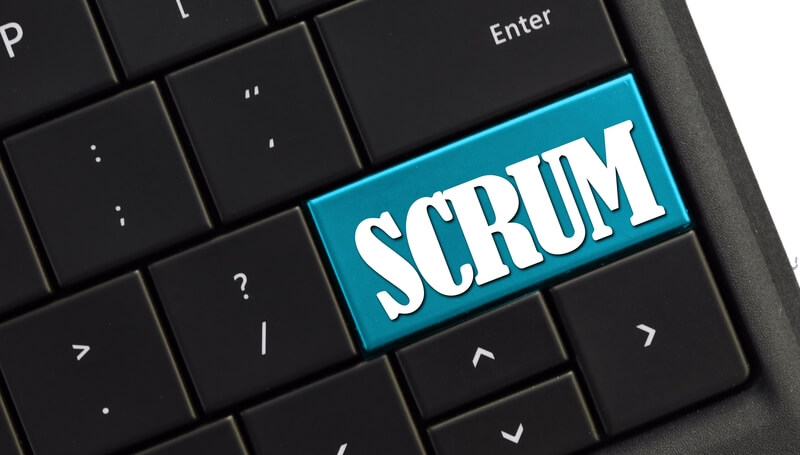What is Scrum – definition, explanation & application
Scrum definition: Is a specific form of project management that is primarily used in agile software development.
There are a number of roles, events and rules that describe the process. Especially in today’s fast-paced world, agile working is becoming increasingly important. As a result, the Scrum method is also being used more and more frequently. Scrum can be applied not only to projects involving software development, but also to many other areas. The following article explains and defines exactly how this works, what needs to be considered and what advantages Scrum brings with it.

Table of contents
- Scrum definition – What is it actually?
- How does Scrum work?
- The roles in Scrum
- Product owner, Scrum master, Team members
- The events during Scrum
- Sprint, Sprint planning, Daily meetings, Sprint review, Sprint retroperspective
- Where is Scrum being used?
- Pros of the Scrum framework, The cons of Scrum
- Conclusion on Scrum
Scrum definition - What is it actually?
Scrum, Scrum framework or Scrum method. This all refers to a form of project management that is primarily known from agile software development. It involves working together as a team on a project. Very regular agreements, exchanges between teams and feedback from managers or customers are essential.
The Scrum framework is about assigning tasks to teams. Clear specifications are set for the end product, but the work is carried out independently and is self-organized. Above all, however, clear schedules must be adhered to and tasks must be processed in a structured and prioritized manner.
However, the best way to explain exactly how Scrum is defined and how it works is to introduce the roles and explain the events that take place during the Scrum method.

How does Scrum work?
In the Scrum framework, there are three different roles that are performed by the people involved. There are also five events that are carried out repeatedly over the course of the project. Scrum can be used both internally and externally for customers and the end product does not have to be a material object or software. Nevertheless, for the sake of simplicity, we will always refer to customers and the product below.
The roles in Scrum
The Scrum method provides for three different role descriptions that are applied to each project team. They are Product Owner, Scrum Master and Team Member. However, the names are not precisely defined. During software development, for example, a team member can also be called a developer.
What is fixed, however, are the tasks that the respective roles should take on. It is important to emphasize that a role can be performed by several people. However, clear responsibilities should be defined at the beginning.
- Product owner
- Scrum master
- Team members
Product owner
The Product Owner is the interface between the customer and the project team. They bear the greatest responsibility. The core elements of their work in the project are regular consultations with the customer, the creation of a catalog of requirements for the product and the allocation of tasks.
During the project, they must keep an eye on all the stakeholders’ interests. In other words, those of the customer, the employees, the rest of the company and, if necessary, those of suppliers or other parties involved. As this requires a lot of work, the product owner is not involved in product development themselves, but only coordinates it.

While there are always several Scrum Masters and team members, ideally there should only be one Product Owner. This has the advantage that only one person distributes instructions and tasks and you don’t have to adapt to several. In the event of problems, there is also one person who can make critical decisions.
Sometimes the product owner does not have to be the interface to the customer, as they are the customer themselves. Otherwise, it is often filled by the client or a team leader of the company.
Scrum master
The next role in the Scrum method is Scrum Master. During a project, several teams are formed with their own responsibilities and areas of activity. These teams are each led by a Scrum Master. He ensures perfect working conditions in the team, coordinates and is in regular contact with the product owner.
They usually get involved in the work themselves and can therefore support the team. However, they cannot change the requirements for the product, as these are specified by the customer and the Product Owner. However, they can help decide on the prioritization of tasks, as they know exactly what the capacities and skills of their team members are.
Team members
Team members form the last role in the Scrum framework. They develop or create the actual product. They organize themselves in consultation with the Scrum Master. Tasks are divided among them in such a way that all members can make the best possible use of their personal skills.
There are no other hierarchical levels. This means that the entire team is on an equal footing and no one can decide over the others. It is not uncommon for team members to be assigned specific responsibilities that they have to take care of. They are therefore very free to organize their own work as long as they adhere to the product specifications and schedules.
There is no perfect team size for a Scrum team, but experience shows that a number of five to ten members is suitable. Teams of this size are large enough to get a lot done, but still small enough to organize themselves well internally.
The events during Scrum

Organization is the right keyword to introduce the various events during the Scrum method. The main focus here is on the sprints. These have to be planned, carried out and then discussed. Daily consultations also take place so that everyone involved is up to date with the progress of the project.
- Sprint
- Sprint planning
- Daily meetings
- Sprint review
- Sprint retroperspektive
Sprint
A sprint is a certain period of time over which certain parts of the project are to be driven forward. The duration of a sprint is determined in advance and is usually the same for the duration of a project. A sprint usually lasts two weeks, but sometimes three or just one. However, a sprint should not last longer than one month.
The previously defined goals should be completed in a sprint. However, it is not uncommon, especially at the start of a project, for a sprint to have too many goals and therefore too many tasks. Too few tasks can also occur. Lessons must then be learned from these experiences so that the next sprint can be planned in a better and more targeted manner.
Sprint planning
This planning of the respective sprints always takes place at the beginning of a period. It discusses what is to be achieved and how it can be implemented. The goals can include specific progress in an area or the completion of a component. The focus is always on the product requirements, which must be used as a guide for each sprint.
In order to achieve the goals of each sprint, tasks are divided up and formulated into smaller orders. These tasks or subtasks are summarized in so-called tickets. A number of tickets are created for each sprint, which then have to be divided up and processed. If further tasks are identified during the sprint that need to be tackled in one of the next sprints, these are also written in tickets.
Common platforms for such ticket systems are Gitlab, Trello or ClickUp. They give you a good overview of who is currently working on what, what has already been finalized and what is still outstanding in the respective sprint.
Daily meetings
Daily meetings are another institution for maintaining an overview. These are often called dailies and take place every day at a fixed time. Here, each team member can briefly explain to the team what they were able to accomplish the previous day and what is planned for today. Problems, new solutions and experiences can also be discussed. However, these dailies should not take up too much time. Therefore, each team member should be as brief as possible.

Traditionally, all the people come together for this event so that they can talk to each other in person. In today’s digital age, however, meetings can of course also take place via video conferencing.
People often stand in the middle of the office and form a circle. Since in these cases people stand for the duration of the meeting, dailies are sometimes also called stand-ups. In other cases, people gather in a meeting room and project the board with the tickets onto the wall in a large format. This allows the team members to review their respective days using their tickets.
Sprint review
A summary of each sprint also takes place at the end. In the sprint review, the entire team and especially the product owner are informed about the progress of the project. Completed sub-projects are reviewed and discussed together. This allows a decision to be made as to whether the result is satisfactory or whether it needs to be optimized in the next sprint.
In contrast to the short daily meetings, a longer time should be scheduled for a sprint review. Only then can everyone have their say and the tasks carried out can be reviewed.
Sprint retroperspective
In addition to the sprint review, in which the completed tasks are discussed from a technical perspective, there is also the retrospective. Here, the completed sprint is also discussed, but the main focus is on social aspects. How did you feel? Did the collaboration go well, especially in terms of agreements? And what can be improved in the next sprint?
Here too, every team member should have their say, as every opinion counts. The retrospective can either take place after the sprint review or in a separate meeting afterwards. In any case, it should be held before the next sprint planning so that the results can be incorporated into the next planning.
Where is Scrum being used?
Scrum is primarily used for project work. Especially when it comes to projects that need to be driven forward very flexibly and where many agreements make sense. From software development to management consultancies. The Scrum method is finding more and more fans and is being used more and more frequently.
One major advantage is that the method itself is also very agile. This means that Scrum can be adapted by each team in order to best project the approach onto their own company or a specific project.
Translated with DeepL.com (free version)

Pros of the Scrum framework
But there are other advantages to the method. Thanks to the clear guidelines on when and how to communicate with each other, there is a regular exchange about progress, but above all about problems. These can then be addressed and solved quickly. This makes the working method very flexible, which ultimately benefits not only each individual team member, but above all the customer.
The clear agreements also ensure a high level of transparency for the various tickets. This means that every stakeholder knows at all times what is being worked on, what has already been completed and what is still outstanding. In addition, task packages can be clearly prioritized, which means that progress is always driven forward during the project.
Finally, Scrum is also ideal for dividing up responsibilities or taking responsibility yourself. Although the greatest responsibility lies with the product owner, each team member takes on an important role. Everyone is responsible for their own area and can learn how to deal with it.
The cons of Scrum
All of this can always be presented beautifully in theory. However, there are also a number of disadvantages, especially if the team does not fit together. In the end, every project manager has to weigh up whether the advantages or disadvantages outweigh the disadvantages.
One major disadvantage is the effort involved. Sprint planning, reviews and retrospectives have to be planned and end up taking up a lot of time. The daily meetings are also short, but they add up. In addition, constant communication with each other requires a great deal of effort. In the worst case scenario, all of this can keep the people involved from working, so that more time is spent on the method than on the actual work.
Personal responsibility can also quickly have negative consequences. Productivity can be disrupted by a lack of work specifications or insufficient targets. In some places, clear instructions simply make sense. Especially when employees work more efficiently with clear guidelines.
After all, interpersonal problems can also quickly arise. Constant communication means you can’t avoid team members with whom you don’t get on so well. This can lead to disputes that ultimately have a negative impact on the entire team.
Conclusion on Scrum
As already mentioned, in the end everyone has to decide for themselves whether the Scrum framework is the right approach for a project. However, experience shows that the advantages of the method outweigh the disadvantages, especially for well-established teams. Perhaps not everything works perfectly the first few times, but over time you can continue to optimise Scrum for yourself.
The Scrum method is also used in some projects at Platri IT. Parts of the method are also used in teams that do not otherwise work with it. Above all, dailies and regular reviews of the work carried out are very useful for a positive corporate culture.

Do you have more questions about Scrum?
You can reach us from Monday to Friday between 9:00 am and 5:30 pm. We look forward to hear from you!
info@platri.de
Phone
0234 497 014 47
Do you have any further questions about our article, this topic or app development costs at Platri IT? Then please get in touch with us. If you are interested in a job at Platri IT, we look forward to your visit to our career portal. We look forward to hearing from you!

